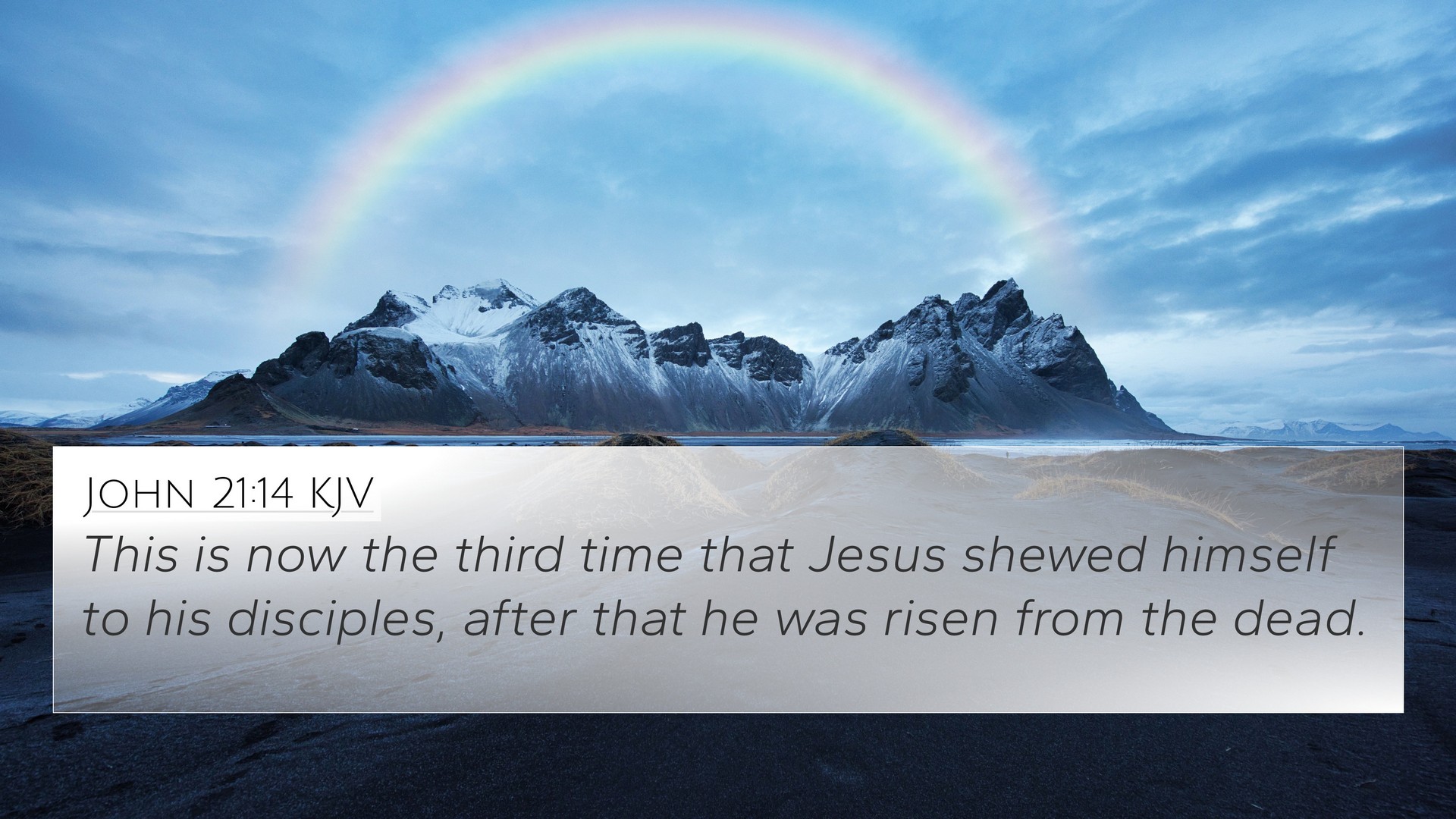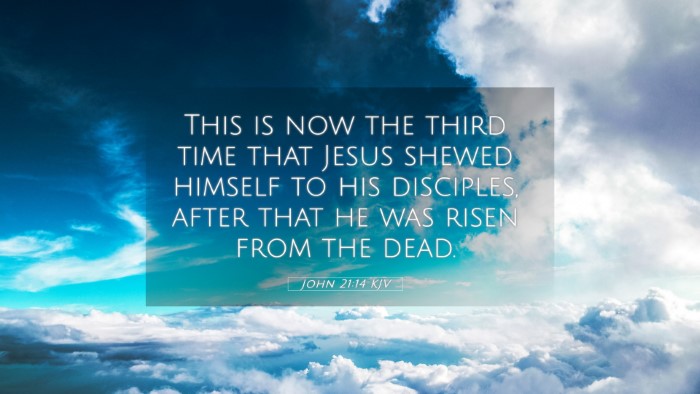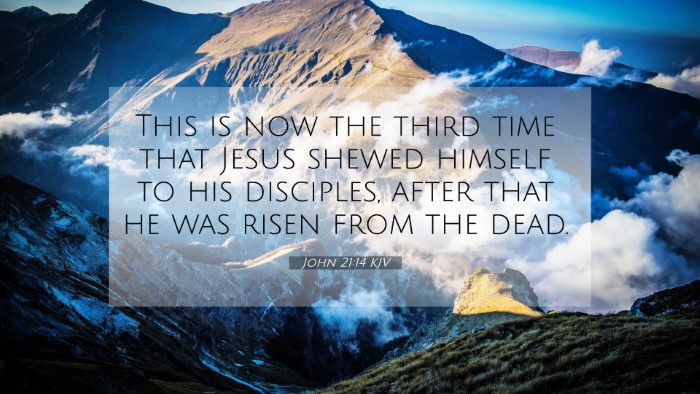Old Testament
Genesis Exodus Leviticus Numbers Deuteronomy Joshua Judges Ruth 1 Samuel 2 Samuel 1 Kings 2 Kings 1 Chronicles 2 Chronicles Ezra Nehemiah Esther Job Psalms Proverbs Ecclesiastes Song of Solomon Isaiah Jeremiah Lamentations Ezekiel Daniel Hosea Joel Amos Obadiah Jonah Micah Nahum Habakkuk Zephaniah Haggai Zechariah MalachiJohn 21:14 Similar Verses
John 21:14 Cross References
This is now the third time that Jesus shewed himself to his disciples, after that he was risen from the dead.
Uncover the Rich Themes and Topics of This Bible Verse
Listed below are the Bible themes associated with John 21:14. We invite you to explore each theme to gain deeper insights into the Scriptures.
John 21:14 Cross Reference Verses
This section features a detailed cross-reference designed to enrich your understanding of the Scriptures. Below, you will find carefully selected verses that echo the themes and teachings related to John 21:14 KJV. Click on any image to explore detailed analyses of related Bible verses and uncover deeper theological insights.
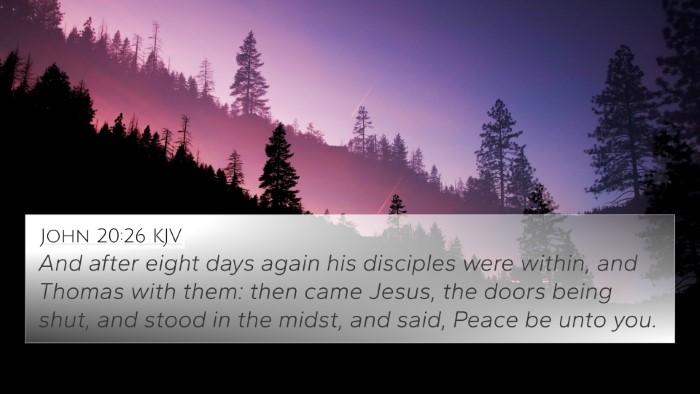
John 20:26 (KJV) »
And after eight days again his disciples were within, and Thomas with them: then came Jesus, the doors being shut, and stood in the midst, and said, Peace be unto you.
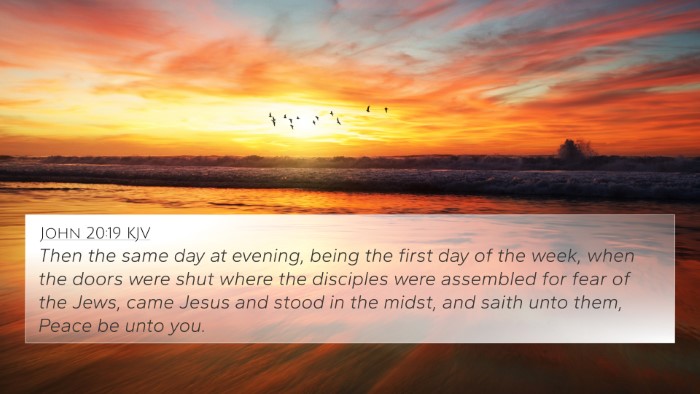
John 20:19 (KJV) »
Then the same day at evening, being the first day of the week, when the doors were shut where the disciples were assembled for fear of the Jews, came Jesus and stood in the midst, and saith unto them, Peace be unto you.
John 21:14 Verse Analysis and Similar Verses
Understanding John 21:14
John 21:14 states, "This is now the third time that Jesus showed Himself to His disciples, after that He was risen from the dead."
This verse holds significant meaning within the context of Jesus' post-resurrection appearances, emphasizing His reality and the assurance He provided to His disciples. The repetition of Jesus showing Himself signifies His desire for His followers to believe in His resurrection fully and to prepare them for their own mission.
Meaning and Interpretation
The importance of this verse can be understood through various commentaries:
- Matthew Henry: Henry emphasizes the personal and relational aspect of Jesus’ appearances. He notes that this third appearance was to reassure the disciples and affirm their calling to ministry.
- Albert Barnes: Barnes points out that this appearance was deliberate to affirm the truth of the resurrection to the disciples, further preparing them for their roles as witnesses of the Gospel.
- Adam Clarke: Clarke elaborates on the significance of the number three in biblical text, suggesting it denotes confirmation and establishes a pattern for the disciples' faith and future ministry.
Bible Verse Cross-References
This verse links to several other scriptures, enriching the understanding of Jesus' post-resurrection appearances and the power of His resurrection:
- Matthew 28:9-10: Jesus appears to the women, reaffirming their role as early witnesses of the resurrection.
- Luke 24:34: Discusses the appearance to Simon Peter, enhancing the personal connection Jesus had with His disciples.
- John 20:19-20: The first appearance to the disciples where He shows His hands and side, bringing them peace.
- Mark 16:7: Acts as a command to the disciples to meet Jesus in Galilee, connecting directly to the context of John 21.
- 1 Corinthians 15:5-7: Paul recounts the appearances of Jesus, including to the twelve and then to more than five hundred, emphasizing the validity of the resurrection appearances.
- Acts 1:3: Confirms that Jesus showed Himself alive after His passion by many infallible proofs.
- John 20:30-31: This passage explains the purpose of the Gospel of John, to convince its readers of the truth of Jesus Christ's ministry and resurrection.
Connections Between Bible Verses
The connections between these verses demonstrate the continuity of the biblical narrative and the themes of resurrection, faith, and divine reassurance. Here are some thematic connections:
- Faith in Resurrection: Each verse reinforces the disciples' belief in Jesus as the Risen Lord.
- Missions and Ministry: The command given to the disciples post-resurrection links to their later actions in Acts.
- Personal Encounters: The personal nature of Jesus' appearances highlights His relationship with His followers.
Thematic Bible Verse Connections
The themes identified in John 21:14 can also be linked across the Bible, demonstrating:
- The Nature of Witnessing: Consistently across both Old and New Testament scriptures, the call to witness God's works is reiterated.
- Identity in Christ: Repeatedly, believers are reminded of their identity and mission stemming from the resurrection.
- Reassurance and Peace: Key themes that unite the post-resurrection appearances of Jesus, offering comfort during uncertainty.
Practical Applications
Understanding John 21:14 and its context invites believers to explore their own faith journey:
- Embrace Your Role: Just as the disciples were prepared for their ministry, believers today are called to embrace their roles in advancing the Gospel.
- Seek Assurance in Christ: Reflect on the personal and profound ways Jesus meets us in our uncertainty.
- Cross-Reference for Deeper Insights: Utilize tools for Bible cross-referencing to explore related scriptures that enhance understanding.
Cross-Referencing Biblical Texts
The process of cross-referencing can deepen one's understanding of any scripture:
- How to Find Cross-References: Use a Bible concordance or cross-reference guide to discover interconnected scriptures that enhance the meaning of John 21:14.
- Identify Connections: Study the links between the Old and New Testament to see how themes manifest throughout the Bible.
- Use Cross-Referencing Tools: Employ Bible study methods that focus on comparative analysis for a richer understanding.
Conclusion
John 21:14 is a pivotal scripture that showcases Jesus' commitment to His disciples after His resurrection. By using a cross-reference approach, one can engage in a deeper study of the complementary themes within the Bible. This method not only enriches the individual’s understanding of a single verse but also brings to light the broader narrative and theology of the scriptures.
